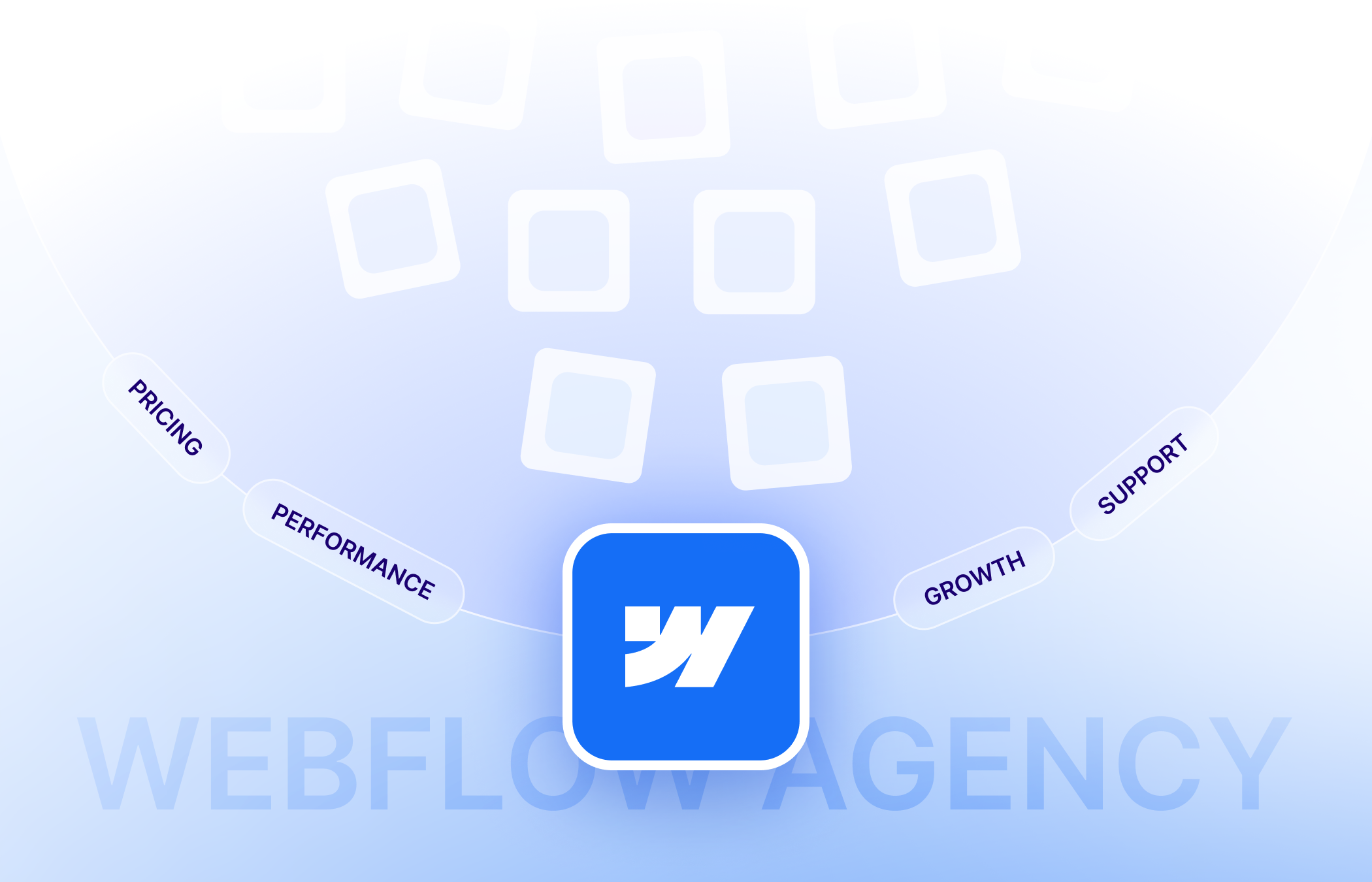Let’s be honest — marketers were never meant to wait in line for dev help.
Yet, that’s the reality for thousands of marketing teams stuck in the trenches of traditional CMS platforms.
Need to change a headline? “Create a ticket.”
Want to launch a landing page for a campaign? “It’s in the sprint.”
Try to update an image? “Sure, but the plugin’s outdated.”
You end up spending more time requesting updates than crafting campaigns.
For years, WordPress, Drupal, and Joomla promised “freedom and flexibility.” In reality, they turned into plugin jungles, version-update nightmares, and dependency traps that slowed marketing to a crawl.
That’s why the rise of Webflow isn’t just a design revolution — it’s a marketing liberation movement.
It puts the power of design, content, and growth directly in marketers’ hands — without code, plugins, or endless developer bottlenecks.
At Loudface, we’ve built dozens of Webflow sites for startups, SaaS brands, and creative teams — and one pattern keeps repeating:
👉 Once marketers get their hands on Webflow, they never want to go back.
Let’s break down exactly why.
The Old Way: When CMS Platforms Slowed Marketing Down
Most marketing teams live inside a content bottleneck disguised as a “CMS.”
- WordPress: once revolutionary, now feels like walking through a plugin minefield.
- Drupal: powerful, but overly technical for non-dev users.
- Squarespace/Wix: simple, but limited and rigid when it comes to scaling or serious design.
Marketers need a CMS that’s fast, flexible, and empowering — not a system that demands maintenance, security patches, and tech babysitting.
Let’s highlight the classic CMS pain points marketers face daily:
1. Endless Plugin Maintenance
Every WordPress marketer knows the fear of seeing “27 plugins need updating.”
Each one is a potential security hole or layout-breaking update. And ironically, you install more plugins to fix what other plugins broke.
2. Slow Page Speeds
Bloated themes, overlapping scripts, and outdated code bloat tank performance. Every extra second of load time hurts conversions and SEO.
Webflow’s CDN-backed pages, by contrast, routinely score 90+ on PageSpeed — without optimization plugins.
3. Design Handcuffs
Themes restrict creativity. You either live with a template or break your site by editing PHP. Marketing teams can’t test bold new layouts or run A/B design experiments without begging devs.
4. Security & Compatibility Issues
Plugins conflict. Themes break. CMS versions require full migrations. One small update can trigger a domino effect of broken pages and lost traffic.
5. Developer Dependency
Every campaign becomes a dev request. Need a new landing page? Two-week wait.
Want to tweak SEO meta tags? File another ticket.
Marketing speed dies in that process.
The truth is — old CMS platforms were built for developers managing content, not marketers driving growth.
And that’s where Webflow completely changes the game.
Webflow’s Secret Sauce: Empowering Marketers, Not Coders
Traditional CMS platforms treat marketers like guests in someone else’s house — welcome to visit, but please don’t touch anything that matters.
Webflow flips that relationship. It’s the only platform that gives marketers full creative control without sacrificing the structure and discipline developers love.
At Loudface, we call this balance the “freedom-within-framework” principle — marketers move fast, but within a system that protects design integrity and performance.
True Visual Editing — Without the Headaches
In WordPress, what you see in the editor rarely matches what you see live.
Webflow changes that with a fully visual editor that’s exactly what your audience will see.
- Move sections, update headlines, replace images — all in real time.
- Every change is reflected instantly on desktop, tablet, and mobile.
- No shortcodes, no plugin conflicts, no HTML tweaks.
For marketers, that means no more guessing. You know exactly how your update will look before it goes live.
“Once clients see Webflow’s Editor, their entire workflow changes — they stop thinking in tickets and start thinking in campaigns.”
— Loudface Design Team
Instant Publishing — Because Timing Matters
Marketing moves at the speed of opportunity. A trending topic hits Twitter. A product update drops. A campaign idea sparks.
In most CMSs, by the time your dev team pushes the change, the moment’s gone.
Webflow lets marketers act instantly:
- Edit → Review → Publish.
- No FTP, no staging merges, no “ask dev to deploy.”
- Built-in version control keeps everything safe.
When you combine this with Webflow’s global CDN and optimized hosting, every update goes live across the world in seconds.
That means campaigns that used to take days can now launch before your coffee gets cold.
Dynamic Content That Scales With You
Static pages are dead. Growth-focused marketing depends on dynamic, scalable content — blogs, case studies, product pages, landing pages.
Webflow’s CMS Collections let marketers manage these effortlessly. Think of them as structured databases — you define fields (title, author, category, CTA link, featured image), and Webflow populates every page automatically.
So you can:
- Duplicate a campaign page and update only key details.
- Manage hundreds of pages from one clean dashboard.
- Keep design consistent across every new asset.
At Loudface, we’ve helped SaaS teams cut landing-page production time by 80% using Collections. It’s marketing at scale — without chaos.
Collaboration That Makes Sense
The war between design, dev, and marketing ends here.
Webflow lets all three teams collaborate natively:
- Designers build components visually.
- Developers fine-tune structure or add custom code.
- Marketers edit copy, publish blogs, and manage content.
All in one platform, all live. No more Google Docs + Slack threads + “who updated that?” mysteries.
It’s not “developer-free.” It’s developer-efficient. Developers set up the system once — marketers drive it every day.
Real Example: How One Marketing Team Stopped Waiting
A B2B SaaS client came to Loudface with a WordPress setup that required a dev for every landing page.
Each request took 2–3 days and involved staging, plugin conflicts, and theme tweaks.
We migrated their site to Webflow, built modular landing-page templates, and trained their marketing team. Within two weeks, they launched 11 new campaigns entirely on their own.
Result?
- 5× faster turnaround time.
- 20% increase in organic traffic (thanks to speed and structure).
- Zero developer backlog.
That’s the kind of independence Webflow was built for.
Built-In SEO and Performance Tools That Actually Matter
When most marketers hear “SEO,” they think of keywords, meta tags, and backlinks. But in reality, technical performance and user experience are half the battle.
Traditional CMSs make SEO a plugin circus — Yoast for titles, RankMath for schema, Smush for images, WP Rocket for speed… you know the drill. Each plugin overlaps or conflicts, dragging down site speed while forcing marketers to learn developer tools.
Webflow simplifies everything.
It bakes SEO, performance, and clean structure right into the core platform — no plugins, no code snippets, no “developer dependency.”
Lightning-Fast by Design
Google’s Core Web Vitals measure how fast a site feels. If your site lags even half a second, your bounce rate spikes and rankings drop.
Webflow is built with performance in its DNA:
- Global CDN: Pages are served from servers closest to the user.
- Automatic image optimization: Webflow compresses and delivers the right format and size for every device.
- Clean, semantic HTML: Unlike bloated theme builders, Webflow exports minimal code — no junk markup, no extra div soup.
- SSL included: No need to install certificates or manage hosting.
In Loudface’s tests, Webflow pages routinely score 90+ in Google PageSpeed Insights and hit all green Core Web Vitals out of the box.
“You can’t optimize what you don’t control. Webflow gives marketers total control — and that’s what makes fast sites possible.”
— Loudface Technical Lead
SEO, But Built In
Every page in Webflow gives marketers direct access to:
- Meta titles & descriptions
- Open Graph (for social sharing)
- Custom URLs & canonical tags
- Alt text for images
- Automatic XML sitemaps
No plugins. No updates. No SEO nightmares.
You can literally preview how your page appears on Google and LinkedIn before hitting publish. That visibility gives marketers confidence — and accuracy — with every campaign.
Example: Launching a new product page?
You can:
- Set the meta title & OG image in seconds.
- Add a canonical tag if it’s a variant.
- Publish instantly and submit to Google Indexing API — all without asking devs.
That’s agility no WordPress setup can match.
Structured Data & Schema Made Simple
Webflow’s clean HTML makes it easier for search engines to interpret your content — and Loudface takes it further by embedding lightweight schema where it counts.
For example:
- Blog posts → Article schema
- Team pages → Person schema
- Case studies → CreativeWork schema
Structured data helps you appear in rich results — boosting click-through rates without extra content.
Real-World SEO Wins
When one of our SaaS clients switched to Webflow, we measured:
- 43% faster load times
- +18% increase in organic traffic in 60 days
- Fewer crawl errors in Google Search Console (thanks to better internal linking + sitemap updates)
They didn’t hire an SEO dev — they just stopped fighting their CMS.
Built for the Future of Search
As Google leans deeper into Core Web Vitals, UX, and structured data, CMSs that rely on plugin stacks will fall behind.
Webflow’s single-stack ecosystem ensures your site evolves automatically — every platform update improves your speed, security, and rendering.
No manual upgrades. No migrations. No downtime.
Content That Scales With You
Marketers today don’t just manage websites — they manage ecosystems.
From blog posts and landing pages to product updates and testimonials, content needs to move fast, stay consistent, and scale cleanly.
But most CMS platforms crumble under that pressure. They rely on rigid templates or manual duplication, turning every update into hours of grunt work.
Webflow’s CMS Collections change that completely.
They give marketers a simple, structured, and scalable way to publish hundreds (even thousands) of pages — all while maintaining pixel-perfect design and brand consistency.
At Loudface, we’ve seen this system revolutionize how marketing teams operate.
Instead of “Can you make me a new landing page?” the question becomes “Which Collection should we add this to?”
Dynamic Content That Feels Handcrafted
Let’s say you’re running a SaaS company with:
- 200 blog articles
- 80 case studies
- 25 landing pages
- 10 product pages
In WordPress, that’s 300+ static pages to manage — each with its own formatting quirks and layout issues.
In Webflow, those are just Collections.
Each Collection has fields for title, description, featured image, CTA, category, etc. You design one master template, and Webflow auto-generates the rest — perfectly formatted, perfectly styled.
Want to update your CTA text across 100 pages? Change it once in the Collection, and Webflow updates everything.
That’s content at scale, minus the chaos.
Marketing Velocity Through Automation
Webflow’s CMS isn’t just efficient — it’s liberating. Marketers can:
- Launch multiple campaigns simultaneously
- Duplicate successful layouts for A/B testing
- Schedule future content drops
- Manage translations or region-specific pages
- Filter and sort dynamically by topic, date, or persona
And because everything is visual, even non-technical team members can contribute — editors, copywriters, designers.
The result: your marketing engine never stalls.
“Once we moved to Webflow, we stopped saying ‘we’ll plan it for next quarter’ and started saying ‘let’s launch it tomorrow.’”
— Loudface client, SaaS Growth Manager
Design Systems That Scale with Your Brand
Here’s where Loudface’s Webflow builds stand apart. We don’t just create CMS structures — we build design systems inside Webflow.
That means reusable components (buttons, sections, modals, forms) that stay visually consistent no matter who edits the site.
So as your brand grows — new features, new audiences, new campaigns — your website evolves with you.
No redesign. No rebuild. No downtime.
Every update keeps the same rhythm, typography, and UX flow your audience already trusts.
Collaboration Without Confusion
Scaling content also means scaling teams.
Webflow’s collaborative editing allows multiple users to:
- Edit copy
- Upload assets
- Review changes
- Publish instantly
No overwriting, no lost drafts, no guessing. It’s like Google Docs for your website — intuitive, controlled, and secure.
And if you pair it with Webflow’s Editor Roles, marketers can safely make updates while developers maintain advanced integrations or custom code.
Everyone works faster, without stepping on each other’s toes.
Real Example: Scaling a Blog From 10 to 250 Articles
A content agency partnered with Loudface to migrate their massive WordPress blog to Webflow. Their goals: cleaner design, better UX, and faster publishing.
We built a CMS Collection with fields for authors, categories, tags, and CTAs. Their marketing team learned the system in one afternoon.
Within six months, they went from 10 to 250 published posts, without a single developer intervention. Organic traffic doubled. Time-to-publish dropped from three days to two hours.
That’s the Loudface advantage — Webflow makes scaling content feel effortless.
Why Developers Still Love It (and That’s the Secret Weapon)
Here’s the twist: while this article is all about how Webflow empowers marketers, the secret to its long-term success is that developers love it too.
Because let’s be honest — no CMS wins inside a company if it alienates the dev team. Developers need structure, scalability, and precision. Marketers need agility. Webflow delivers both.
At Loudface, our developers describe Webflow as “a marketer’s dream that doesn’t make engineers cringe.”
Here’s why 👇
Clean, Maintainable Code
Unlike traditional visual builders that produce bloated HTML, Webflow outputs clean, semantic code.
That means:
- Faster load times
- Easier integration with analytics and automation tools
- Clear hierarchy for accessibility and SEO
Developers can export code directly, customize scripts, or integrate with APIs. Nothing’s locked away.
It’s visual and technical — the perfect hybrid for modern teams.
Custom Code Without Chaos
Just because it’s no-code for marketers doesn’t mean it’s no-power for devs. Webflow supports embedded scripts, APIs, and custom CSS directly in the designer.
Need advanced tracking? Connect GA4, Segment, or HubSpot in minutes. Want a custom calculator, animation, or booking form? Drop in JavaScript or third-party embeds seamlessly.
This means developers stay in control of the tech stack — without acting as gatekeepers for marketing. The result is harmony, not hierarchy.
No More “Design vs. Dev” Battles
Traditionally, design files move from Figma → Dev → QA → Marketing → Launch. By the time the page goes live, the vision’s diluted.
Webflow collapses that chain into one shared environment. Designers build visually, devs enhance functionality, and marketers publish content — all in the same ecosystem.
When your design system, CMS, and hosting live together, you remove the friction that kills speed and creativity. That’s why Loudface calls Webflow the single source of truth for modern websites.
The Future of Marketing Runs on Webflow
The days of separating “content management” from “brand experience” are over.
Marketers need control. Developers need clean systems. Users need fast, beautiful sites.
Webflow unites all three — and that’s what makes it quietly revolutionary.
It’s not just a CMS; it’s a marketing engine. One that’s visual, scalable, and built for the modern web.
At LoudFace, we’ve seen firsthand how moving to Webflow transforms teams:
- Faster launches: From weeks to hours
- Consistent design: Every new page matches brand identity
- Technical stability: No plugins, no downtime, no migrations
- SEO wins: Cleaner structure, faster speeds, higher rankings
- Empowered marketers: Fewer tickets, more campaigns
When your CMS stops being a bottleneck, your marketing finally breathes.
The LoudFace Philosophy: Be Bold, Move Fast, Stay Loud
We don’t just build Webflow sites. We build marketing ecosystems — the kind that scale effortlessly and make every brand look, feel, and perform premium.
Whether you’re launching a SaaS product, revamping a corporate site, or turning a Figma dream into a living experience — our team designs, builds, and optimizes every pixel with purpose.
Because your website isn’t just your digital storefront. It’s your loudest voice. And LoudFace makes sure it’s heard.
Take Back Control of Your Website
If your marketing team is tired of waiting on developers, wrestling plugins, or fighting CMS limitations — it’s time for a platform that moves at your speed.
Webflow is secretly (and not so secretly anymore) the best CMS for marketers because it combines beauty, power, and autonomy. It’s fast, flexible, and future-proof — everything a growing brand needs.
So whether you’re a startup founder, a CMO, or a creative agency — if you’re ready to unlock your website’s full potential,
👉 Book a strategy call with Loudface and see how we build Webflow sites that rank, convert, and impress.
Your ideas deserve to be loud.
Let’s make them impossible to ignore.







